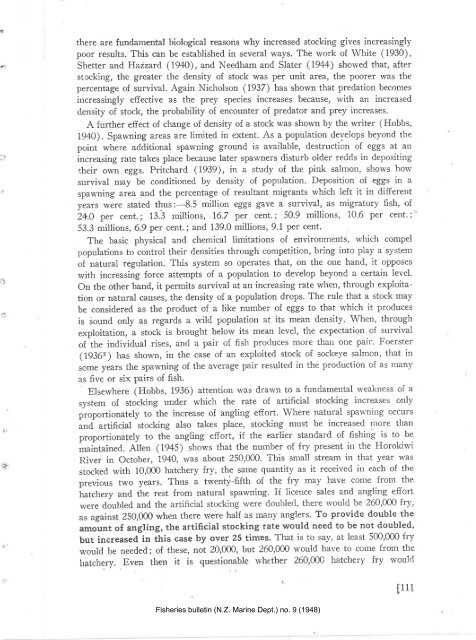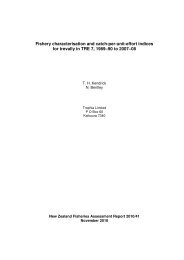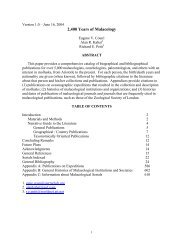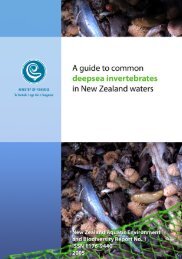N.Z. MARINE DEPARTMENT-FISHERIE,S BULLETIN No. .į
N.Z. MARINE DEPARTMENT-FISHERIE,S BULLETIN No. .į
N.Z. MARINE DEPARTMENT-FISHERIE,S BULLETIN No. .į
You also want an ePaper? Increase the reach of your titles
YUMPU automatically turns print PDFs into web optimized ePapers that Google loves.
there are fundamental biological reasoirs why increased stocking gives increasingly<br />
poor results. This can be established in several ways. The work of White (1930),<br />
Slretter and}J.aizard (19,+O), and Needham and Slater (1944) showed that, after<br />
stocking, the greater the density of stock was per unit area, the poorer was the<br />
percentage of survival. Again Nicholson (1937) has shown that predation becomes<br />
increasingly effective as the prey species increases because, with an increased<br />
clensity of stock, the probability of encounter of predator and prey increases.<br />
A further effect of change of density of a stock was shown by the writer (Hobbs,<br />
I94O). Spawning areas are limited in extent. As a population develops beyond the<br />
point where additional spawning ground is available, destruction of eggs at an<br />
increasing rate takes place because later spawners disturb older redcls in depositing<br />
cheir own eggs. Pritchard (1939), in a study of the pink salmon, shows how<br />
survival may be conditioned by density of population. Deposition of eggs in a<br />
spawning area and the percentage of resultant migrants which left it in different<br />
years were stated thus:-8.5 million eggs gave a survival, as migratory fish, of<br />
24.0 per cent.; 13.3 millions, 16.7 per cent'; 50.9 millions, 10.6 per cent.;<br />
53.3 millions, 6.9 per cent.; and 139.0 millions, 9.1 per cent.<br />
The basic physical and chemical limitations of environments, which compel<br />
populations to control their densities through competition, bring into play a system<br />
of natural regulation. This system so operates that, on the one hand, it opPoses<br />
with increasing force attempts of a population to develop beyond a certain level.<br />
On the other hand, it permits survival at an increasing rate when, through exploitation<br />
or natural causes, the density of a population drops. The rule that a stock may<br />
be considered as the product of a like number of eggs to that which it produces<br />
is òound only as regards a wild population at íts mean density. \Mhen, through<br />
exploitation, a stock is brought belorv its mean level, the expectation of survival<br />
of the individual rises, and a pair of fish produces more thau one pair. Foerster<br />
(19362) has shown, in the case of an exploited stock of sockeye salmon, that in<br />
some years the spawning of the average pair resulted in the procluction of as many<br />
as five or six pairs of fish.<br />
Elsewhere (Hobbs, 1936) attention was clrawn to a fundamental rveakness of a<br />
system of stocking under which the rate of artificial stocking iucreases only<br />
proportionately to the increase of angling effort. Where natural sparvning occurs<br />
a¡¿ artificial stocking also takes place, stocking must be increased more than<br />
proportionately to the angling elÏort, if the earlier standard of fishing is to be<br />
maintained. Allen (1945) shows that the number of fry present in the Horokiwi<br />
River in October, 1940, was about 250,000. This small stream in that yeaf was<br />
stocked with 10,000 hatchery fry" the same quantity as it receivecl in each of the<br />
previous two years. Thus a twenti-fifth of the fry may have come from the<br />
-hatchery and the rest from natural spawning. If licence sales and angling effort<br />
were dóubled and the a¡tificial stocking were doul¡lecl, there rvould be 260,000 fry,<br />
as against 250,000 when there were half as lnany anglers. To provide double the<br />
amount of angling, the artificial stocking rate would need to be not doubled'<br />
but increased in this case by over 25 times. That is to say, at least 500,000 fry<br />
would l¡e needed; of 'these, not 2O,0OO, but 260,000 lvoulcl have to cotne from the<br />
lratcherv. Even then it is guestionable .rvhether 26o,aæ' hatcher¡' fry rvoultl<br />
Fisheries bulletin (N.Z. Marine Dept.) no. 9 (1948)<br />
[111







